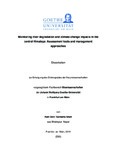Please use this identifier to cite or link to this item:
http://archive.nnl.gov.np:8080/handle/123456789/275| Title: | Monitoring river degradation and climate change impacts in the central Himalaya: Assessment tools and management approaches |
| Authors: | Shah, Ram Devi Tachamo |
| Keywords: | Rivers Biodiversity Freshwater ecosystem Macroinvertebrates Climate change Central Himalaya |
| Issue Date: | 20-Feb-2018 |
| Abstract: | River ecosystems are some of the most diverse habitat on the Earth and alone provide significant ecosystem services to human well-beings. However, they are highly threatened habitats amongst others as they have been center for human settlement. Alterations in flow regimes, habitat degradation, and water quality deteriorations have raised severe concerns in all parts of the World. Central Himalaya, Nepal, is no longer exception making river degradation as serious environmental concern among people and government. Currently many rivers flowing through urban areas have exhibited poor ecological status and lost river biota. A more recent problem is contemporary climate change further impacting river ecosystems and their biota and often acts synergistically with other stressors exacerbating the effects. The country’s water resources and river flows are maintained by glacier melts and monsoon which are both sensitive to climate change. Impacts on biodiversity (such as range shifts, local/global extinctions, spread of invasive species, formation of novel communities) brought by climate change is enormous. Ecosystem services provided by the freshwater resources are under severe pressure and are likely to exacerbate and the people depending on such services for their livelihood are at risk. The weak institutional capacity of country to cope with wide range of stressors including climate change has made the 4th most vulnerable country in the world. However, there is a lack of assessment methods for both problem areas. For maintaining and protecting the ecological integrity of rivers and its biodiversity to continue ecosystem services, regular monitoring of the river ecosystems is imperative. The overall objective of this thesis is to provide standardized biological techniques and modelling approaches to assess the impacts of river degradation and climate change on stream benthic macroinvertebrates assemblages of the Himalayan streams and rivers. While the country has several biological techniques for assessing the impacts of river pollution, I compared the performance of different indices to suggest the best suited biotic index (Chapter 2) and applied the method for categorization of river stretches along the longitudinal gradient (Chapter 3). In contrary, no method has been identified so far for evaluating potential impacts of climate change on river biodiversity (particularly stream benthic macroinvertebrates) in the Himalaya, I used bioclimatic envelope models (BEMs) as a first approach to investigate the climate change driven range shifts in Odonata species (Epiophlebia laidlawi) (Chapter 4) and developed climate sensitive zone (CSZ) for monitoring of climate change impacts on river ecosystems (Chapter 5). The performance of five biotic indices namely NEPbios, BRSbios, GRSbios, HKHbios and NEPbios-Extended were compared by using extensive data sets (Chapter 2). Based on simple linear regression and Receiver Operating Characteristics (ROCs) Curves analyses, GRSbios index was identified as the robust index for the country. In Chapter 3, the evaluation of stream benthic macroinvertebrates composition distinguished three zones such as: unpolluted, moderately polluted and extremely polluted along the river gradient for premonsoon and post-monsoon seasons. The study also revealed that the polluted river stretches shifted upstream segments during pre-monsoon compared to post-monsoon season. Bioclimatic envelope models (BEMs) was applied to predict the potential impact of climate change on the distribution of stream benthic macroinvertebrates taxa in the Himalaya (Chapter 4). The BEMs have provided first approximation of climate change impact on river biota. The models projected that the species (Epiophebia laidlawi) would shift to higher altitudes and latitudes in response to climate warming. In the Himalaya, the potential impacts of climate change are likely to vary along the altitudinal gradients suggesting some higher elevational bands are more sensitive than lower elevations to increasing warming rate. In chapter 5, I determined Climate Sensitive Zone (CSZ) by means of the highest species turnover between the consecutive altitudinal bands. The LOESS curve indicated greatest turnover among altitudinal bands between 2900 and 3500 m asl. This altitudinal band may help for efficient monitoring of climate change on river ecosystems as any impacts of climate change would be first visible in the sensitive zone. The methods and approaches identified in this thesis would help water managers, conservationists and ecologists for assessments and monitoring of impacts of major anthropogenic stressors including climate change on river ecosystems and their biodiversity. |
| Description: | Dissertation submitted to the Department of Life Sciences for the Degree of Doctor of Natural Sciences, the Johann Wolfgang Goethe University, 2014. |
| URI: | http://103.69.125.248:8080/xmlui/handle/123456789/275 |
| Appears in Collections: | 500 Natural sciences and mathematics |
Files in This Item:
| File | Description | Size | Format | |
|---|---|---|---|---|
| RDTS_Phd thesis.pdf | 4.11 MB | Adobe PDF |  View/Open |
Items in DSpace are protected by copyright, with all rights reserved, unless otherwise indicated.